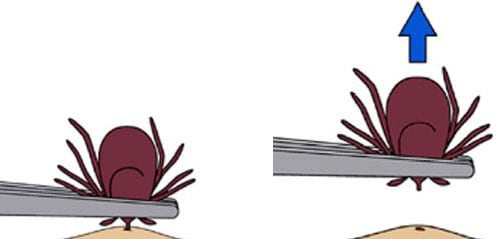 It’s that time again – and it is getting worse by the year – we’re talking about Lyme Disease.
It’s that time again – and it is getting worse by the year – we’re talking about Lyme Disease.
Blacklegged ticks carry the bacteria that cause Lyme and are found mainly in the northeast, mid-Atlantic, and north-central United States. Nymphs, or immature ticks, are the most common Lyme culprit and, unfortunately, also the most difficult to spot since they’re so small. They often can be found burrowed in the groin, armpits, or scalp. The sooner you catch them the better, as transmission of the bacterium increases significantly after 24 hours. Removing a tick right away will lower the chance of exposure to Lyme disease dramatically. The hardest part is once a tick is attached it needs to be removed carefully and properly or the mouthpart can break off into the skin and Lyme can still be transmitted. The entire tick including the mouthpart needs to be removed.
Prevention is Definitely Key!
Ticks live in wooded and bushy areas with high grass so if you can avoid these areas that is your best bet. If you are in these areas, wear long sleeve shirts and pants, and use repellent on skin, clothing, and gear. When you return from these wooded areas, always do a full-body check for ticks. Also be sure to do a full body check on your pet! And check any gear you had with you. It can also help to go over your clothes and skin and your pet’s fur with a lint roller, which the ticks can stick to – especially when they are the tiny ones that are hard to see. If you were wearing dark clothes or are afraid you could have missed a tick on your clothes, put them in a drying machine on high heat, which can kill the tick. Ticks thrive in moisture so when they dry out they will die.
Remember - health officials say the best prevention is vigilance by doing once or twice overs of yourself and your pet after coming back indoors.
If you do find a tick and it IS already attached, now what? Earlier we mentioned you MUST remove the tick correctly!
How to Safely Remove a Tick:
- Use fine-tipped tweezers to grasp the tick as close to the skin’s surface as possible.
- Pull upward with steady, even pressure. Don’t twist or jerk the tick; this can cause the mouth-part to break off and remain in the skin. If this happens, remove the mouth-parts with tweezers. If you are unable to remove the mouth easily with clean tweezers, leave it alone and let the skin heal.
- After removing the tick, thoroughly clean the bite area and your hands with rubbing alcohol, an iodine scrub, or soap and water.
- Dispose of a live tick by submersing it in alcohol, placing it in a sealed bag/container, wrapping it tightly in tape, or flushing it down the toilet. Never crush a tick with your fingers.
If you have been bitten by a tick you must keep your eye on the area. If you develop a rash or if the area looks abnormal, you need to see a doctor.

Early Signs and Symptoms (3 to 30 days after tick bite)
- Flu-like symptoms including fever and chills
- Headache
- Fatigue
- Muscle and joint aches
- Swollen lymph nodes
- Erythema migrans (EM) rash:
- Occurs in approximately 70 to 80 percent of infected persons
- Begins at the site of a tick bite after a delay of 3 to 30 days (average is about 7 days)
- Expands gradually over a period of days reaching up to 12 inches or more (30 cm) across
- May feel warm to the touch but is rarely itchy or painful
- Sometimes clears as it enlarges, resulting in a target or “bull’s-eye” appearance
- May appear on any area of the body
Later Signs and Symptoms (days to months after tick bite)
- Severe headaches and neck stiffness
- Additional EM rashes on other areas of the body
- Arthritis with severe joint pain and swelling, particularly the knees and other large joints.
- Facial palsy (loss of muscle tone or droop on one or both sides of the face)
- Intermittent pain in tendons, muscles, joints, and bones
- Heart palpitations or an irregular heart beat
- Episodes of dizziness or shortness of breath
- Inflammation of the brain and spinal cord
- Nerve pain
- Shooting pains, numbness, or tingling in the hands or feet
- Problems with short-term memory
